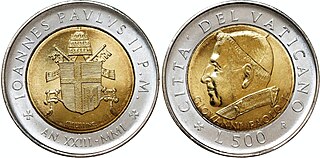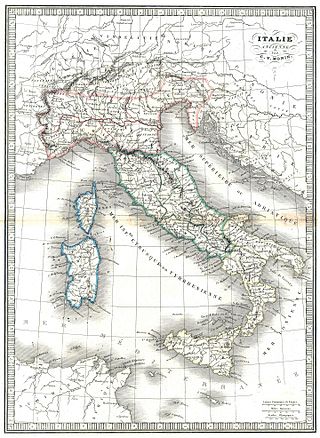
The Italian Somaliland lira also called the Somali lira (Italian : lira somala), was a special version of the Italian lira minted in Italian Somaliland between 1925 and 1926. [1]

The Italian Somaliland lira also called the Somali lira (Italian : lira somala), was a special version of the Italian lira minted in Italian Somaliland between 1925 and 1926. [1]
The Italian government decided to introduce the Italian lira into the colony. Decree No.1143 of 18 June 1925 authorized the introduction of the lira as legal tender, replacing the Italian rupee. (However, the Indian rupee continued to circulate as non-legal tender.) In order to introduce the lira, a period of exchange commenced on 1 July 1925 and ended on 30 June 1926. During this period, the Bank of Italy at Mogadishu exchanged the rupees for lire at a rate of eight lire per rupee. The lira proved to be an acceptable and reliable currency for the colony, but there developed an opinion in Italy, that it might be wiser to have a separate currency for its colonies (including Eritrea & Somalia), which would be linked to the lira, rather than allowing the Italian lira to circulate in its colonies. Peter Symes
The "Italian Somali Lira" replaced the Italian Somaliland rupia at a rate of 8 lire = 1 rupia. Only coins of £5 and £10 were issued, which circulated alongside Italian coins and banknotes. From 1938, banknotes for the Italian East African lira also circulated. The coin circulation officially lasted until 1941.
In 1925, silver coins in denominations of 5 and 10 lire were issued. [2]
They were slightly larger than the 5 and 10 lire coins introduced in Italy the following year. The issue was approved by the Royal Decree of 18 June 1925, n. 1143, contextually put out over the former "Somalia Rupia". To the reverse there was the Arms of Somalia era: lion passant and three six-pointed stars. The Coat of Arms, between two branches, was crowned. Legends were only in Italian.
| Coins | ||||
|---|---|---|---|---|
| Value | Straight | Reverse | first minting | off the course |
| 5 lire | Vittorio Emanuele III di Savoia with king crown. Under him the word MOTTI, the image creator Attilio Motti. | Coat of Arms of "Somalia italiana": lion with 3 stars crown. Around the words SOMALIA ITALIANA. | 1925 | 1926 |
| 10 lire | ||||
| Preceded by: Italian Somaliland rupia Ratio: 8 lire = 1 rupia | Currency of Italian Somaliland together with ordinary Italian lira 1925 – 1926 Concurrent with: Italian lira | Succeeded by: Italian lira Ratio: at par |

The shilling is a historical coin, and the name of a unit of modern currencies formerly used in the United Kingdom, Australia, New Zealand, other British Commonwealth countries and Ireland, where they were generally equivalent to 12 pence or one-twentieth of a pound before being phased out during the 1960s and 1970s.

The Bangladeshi taka is the currency of Bangladesh. In Unicode, it is encoded at U+09F3৳BENGALI RUPEE SIGN.

The Sri Lankan Rupee is the currency of Sri Lanka. It is subdivided into 100 cents, but cents are rarely seen in circulation due to its low value. It is issued by the Central Bank of Sri Lanka. The abbreviation Re (singular) and Rs (plural) is generally used, the World Bank suggests SL Rs as a fully disambiguating abbreviation for distinction from other currencies named "rupee".

The lira or pound was the currency of Malta from 1972 until 31 December 2007. One lira was divided into 100 cents, each of 10 mils. After 1986 the lira was abbreviated as Lm, although the original £M sign continued to be used unofficially. In English the currency was still frequently called the pound even after its official English language name was changed to lira.

The birr is the primary unit of currency in Ethiopia. It is subdivided into 100 santims.

The lira was the currency of Italy between 1861 and 2002. It was introduced by the Napoleonic Kingdom of Italy in 1807 at par with the French franc, and was subsequently adopted by the different states that would eventually form the Kingdom of Italy in 1861. It was subdivided into 100 centesimi, which means "hundredths" or "cents". The lira was also the currency of the Albanian Kingdom from 1941 to 1943.

The Somaliland shilling is the official currency of the Republic of Somaliland, an unrecognised sovereign state in the Horn of Africa, recognised internationally as de jure part of Somalia.

The dinar is the currency of Bahrain. It is divided into 1000 fils. The Bahraini dinar is abbreviated د.ب (Arabic) or BD (Latin). It is usually represented with three decimal places denoting the fils.

The Somali shilling is the official currency of Somalia. It is subdivided into 100 senti, cents (English) or centesimi (Italian).

The Djiboutian franc is the currency of Djibouti. Its ISO 4217 currency code is DJF. Historically, it was subdivided into 100 centimes.

The East African shilling was the sterling unit of account in British-controlled areas of East Africa from 1921 until 1969. It was issued by the East African Currency Board. It is also the proposed name for a common currency that the East African Community plans to introduce.

The lira was the currency of the Vatican City between 1929 and 2002. It was not a separate currency but an issue of the Italian lira; the Banca d'Italia produced coins specifically for Vatican City.
The lira was the currency of San Marino from the 1860s until it was replaced by the euro on 1 January 2002. It was equivalent and pegged to the Italian lira. Italian coins and banknotes and Vatican City coins were legal tender in San Marino, while Sammarinese coins, minted in Rome, were legal tender throughout Italy, as well as in the Vatican City.

The Somalo was the currency of the Trust Territory of Somaliland administered by Italy between 1950 and 1960. The "Somalo" remained officially in use in the newly created Somali Republic until 1962. It was subdivided into 100 centesimi.

The Palestine pound was the currency of the British Mandate of Palestine from 1 November 1927 to 14 May 1948, and of the State of Israel between 15 May 1948 and 23 June 1952, when it was replaced with the Israeli pound.

The Italian East African lira was a special banknote circulating in Italian East Africa between 1938 and 1941.

The Somali rupia was the currency in Italian Somaliland from 1909 to 1925. It was subdivided into 100 bese.
The scudo was the currency of Milan until 1806. It was subdivided into 6 lire, each of 20 soldi or 240 denari.
British involvement in the Middle East began with the General Maritime Treaty of 1820. This established the Trucial States and the nearby island of Bahrain as a base for suppressing sea piracy in the Persian Gulf. Meanwhile, in 1839 the British East India Company established an anti-piracy station in Aden to protect British shipping that was sailing to and from India. Involvement in the region expanded to Egypt in 1875 because of British interests in the Suez Canal, with a full scale British invasion of Egypt taking place in 1882. Muscat and Oman became a British Protectorate in 1891, and meanwhile Kuwait was added to the British Empire in 1899 because of fears surrounding the proposed Berlin-Baghdad Railway. There was a growing concern in the United Kingdom that Germany was a rising power, and about the implications that the proposed railway would have as regards access to the Persian Gulf. Qatar became a British Protectorate in 1916, and after the First World War, the British influence in the Middle East reached its fullest extent with the inclusion of Palestine, Transjordan and Iraq.

Italy has a long history of different coinage types, which spans thousands of years. Italy has been influential at a coinage point of view: the medieval Florentine florin, one of the most used coinage types in European history and one of the most important coins in Western history, was struck in Florence in the 13th century, while the Venetian sequin, minted from 1284 to 1797, was the most prestigious gold coin in circulation in the commercial centers of the Mediterranean Sea.